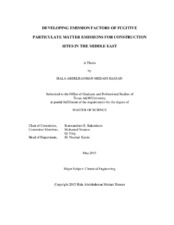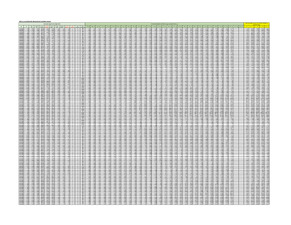| dc.description.abstract | A major source of airborne pollution in the arid Middle East countries is the fugitive particulate matter (PM), a frequent product of wind erosion. The meteorological conditions and topography of this region makes it highly susceptible to wind-blown particles which raise many air quality concerns. Important tools for estimating the dispersion and deposition of dust particles, which also help in designing dust control procedures, are Air Quality Models (AQM). The cornerstone of every AQM system is an emission inventory, but these are only available currently for the European and North American domains, calling for an immediate need to develop similar knowledge for MEA.
The increasing level of urbanization in Middle East countries has thrown the light on the airborne pollution caused by construction and earth work activities. The main scope of the present study is to develop fugitive particulate matter emission factors for construction sites in MEA and to evaluate the accuracy of the existing emission factors to apply for Middle Eastern hot and arid conditions. An experimental campaign along with dispersion modeling using the Fugitive Dust Model (FDM) were implemented in a construction site to examine the relation between the meteorological variables, concentrations and emission rates to understand the behavior of the fugitive dust emissions for MEA. The time period of this work was chosen while the construction site was at rest, where the only particles source was wind erosion of the loose soil. A data analysis was done, using the modeling results, to identify the effect of each meteorological variable (i.e. wind direction, wind speed, stability, .etc.) and its relation to emissions concentrations and rates. Considering the wind-speed dependence of the source emission rate, a power law function was obtained for the calculation of the emission rates. This function was used to re-run the FDM model and the results were evaluated compared to the on-site measured concentrations and to the emission factors reported in USEPA’s AP-42 (the related emission rates in this emission inventory have been developed mainly for open coal-mines). Surprisingly, our study showed that a very good agreement between the AP-42 emission factors and our calculations can be obtained if the former are slightly modified. The emission factors developed in this study have been confirmed and can be applied for the impact assessment of similar sources in Middle East and other dry-arid locations. | en |



